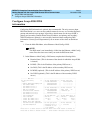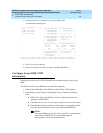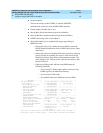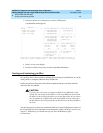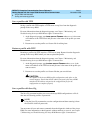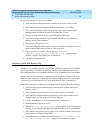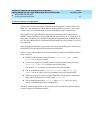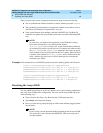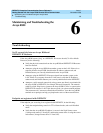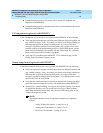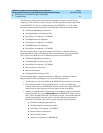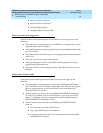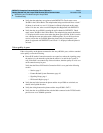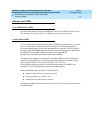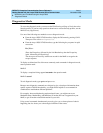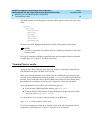
Maintaining and Troubleshooting the Avaya R300
89Troubleshooting
6
DEFINITY Enterprise Communication Server Release 9
Getting Started with the Avaya R300 Remote Office Communicator
Issue 1
November 2000
6
Maintaining and Troubleshooting the
Avaya R300
Troubleshooting
No IP connectivity between Avaya R300 and
DEFINITY IP Resource
If the Avaya R300 cannot “ping” to a DEFINITY IP resource board (C-LAN or Media
Processor), do the following:
■ Verify the physical connection from the Avaya R300 and DEFINITY IP Resource
board to network.
■ Attempt to ping the Avaya R300 from another system on the LAN. If there is no
response from the Avaya R300, check that the IP address, subnet mask, and
Default Gateway are correctly administered on the Avaya R300.
■ Attempt to ping the DEFINITY IP resource board from another system on the
LAN. If there is no response from the C-LAN board, verify that its IP address,
subnet mask, and Default Gateway are correctly administered on the DEFINITY.
■ Attempt to verify network connectivity using systems not directly associated with
the Avaya R300 or DEFINITY (for example, Personal Computers). The network
could be at fault. Ping from a system on the Avaya R300's LAN to a system on the
DEFINITY IP resource's LAN. If this does not work, you a have network problem.
The traceroute tool (“traceroute <Destination IP address>” from the Avaya R300
terminal server prompt) can help you pinpoint the source of the network failure.
Endpoint not registered with DEFINITY
If the endpoint you are testing is not registered with DEFINITY, do the following:
■ Verify that endpoint being tested is in TTI or Named mode, and not in Disabled
mode.
■ Verify that the Avaya R300’s IP address is correct in the Node Names screen
(“change node-names ip” from SAT), and that the remote office is using the correct
node names (“change remote-office x” from SAT).



